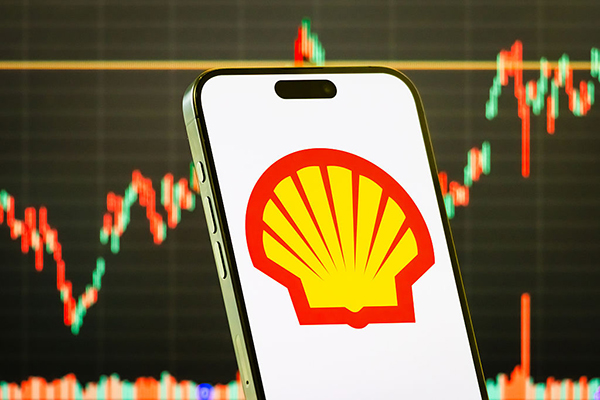Oil sector top picks: what the City thinks of Shell and BP
A new report includes some changes to this analyst’s view on the oil majors. City writer Graeme Evans runs through the details.
3rd September 2025 15:24
by Graeme Evans from interactive investor

Picture: Cheng Xin/Getty Images.
Shell remains the top pick of a City bank after its analysts published a cautious report that warned of downside risks to share buybacks across Europe’s Big Oil sector.
Morgan Stanley has an Overweight stance on Shell (LSE:SHEL) and TotalEnergies SE (EURONEXT:TTE), believing the FTSE 100 giant is “particularly well placed” to cope with a coming period of commodity price uncertainty.
- Invest with ii: SIPP Account | Stocks & Shares ISA | See all Investment Accounts
Its Shell price target of 2,860p represents a potential 5% upside, while BP (LSE:BP.) has been raised to Equalweight but with a 400p price estimate that sits well below today’s level.
Morgan Stanley said industry upstream portfolios remain in “rude health” but that its view of the sector continued to be dominated by the outlook for commodity prices.
It anticipates a period of several quarters during which the oil market is oversupplied, with the potential for this to drive front-month Brent crude futures towards $60 (£45) a barrel.
The outlook for oil and gas prices means consensus earnings estimates are likely to fall further, continuing the downward trend from the “extraordinarily high levels” of 2022.
This in turn creates downside risk to share buybacks, particularly as European majors have taken on more debt in the last several quarters to fund capital expenditure, dividends and other committed outlays such as lease payments and hybrid bond coupons.
- Huge month for dividends as Lloyds Bank, BP, Shell, L&G pay out
- Why investors shouldn’t worry about weak stocks in September
- Dividend play M&G suffers profit miss but inflows surprise
The bank points out that net debt still rose over the last four quarters, even when the average Brent price was at $74 a barrel.
The current consensus distribution yield, which takes into account dividends and buybacks as a percentage of market capitalisation, is 9.8% next year.
However, Morgan Stanley said comparing this to the adjusted free cash yield of 4.4% shows “genuine” cash flow covering about half the distributions.
It expects cuts to buybacks at all majors except BP, which has already reduced its programme to $750 million from the $1.75 billion announced in results for the final quarter of 2024.
The view on BP’s buyback is a “close call”, however as Morgan Stanley said much will depend on the execution of a disposal programme that includes the potential sale of Castrol.
The bank’s previous Underweight thesis was based on BP’s high balance sheet gearing, low adjusted free cash flow yield and disappointing quarterly earnings delivery.
Second-quarter results were the first out of many where BP beat consensus expectations, partly driven by long-awaited operational improvements in the Customers & Products segment.
Morgan Stanley said: “One quarter does not make a new trend, but at least the stretch of quarterly misses appears to have been broken.
“BP remains exposed to oil and gas price sensitivity, but the proposed Castrol disposal, hints of renewed operational momentum, exploration success, and a new chair arriving at the company soon also has the potential to support the shares.”
- ii view: BP shares recover while strategy revamp continues
- Stockwatch: does AI justify this cyclical share’s growth rating?
- UK bank shares and the impact of a Budget tax swoop
Shell is regarded as having the strongest balance sheet among peers, with the highest adjusted free cash flow yield at about 7.2% in 2026.
These characteristics and the benefit of self-help measures under management’s control should make Shell resilient in an uncertain macro environment.
The bank expects that Shell will reduce its share buyback programme at some point, but not below the $3 billion per quarter level.
This would represent a modest reduction from the current rate of $3.5 billion, while it believes this downgrade will come much later than for its peers.
Combined with a dividend of $8.2 billion, a buyback run-rate of $12 billion a year equates to an approximate 10% total distribution yield, which Morgan Stanely regards as compelling.
Dividend per share growth is currently guided at 4% per year, which given the impact of buybacks implies that the total dividend outlay slowly shrinks over time.
The bank assumes Shell raises its dividend by 4% at both the 2025 and 2026 full-year results before a period of 10% annual dividend growth in the following six years.
It added: “We argue this is both affordable and necessary to catalyse the shares and can be achieved by changing the mix between dividends and buybacks over time.”
These articles are provided for information purposes only. Occasionally, an opinion about whether to buy or sell a specific investment may be provided by third parties. The content is not intended to be a personal recommendation to buy or sell any financial instrument or product, or to adopt any investment strategy as it is not provided based on an assessment of your investing knowledge and experience, your financial situation or your investment objectives. The value of your investments, and the income derived from them, may go down as well as up. You may not get back all the money that you invest. The investments referred to in this article may not be suitable for all investors, and if in doubt, an investor should seek advice from a qualified investment adviser.
Full performance can be found on the company or index summary page on the interactive investor website. Simply click on the company's or index name highlighted in the article.